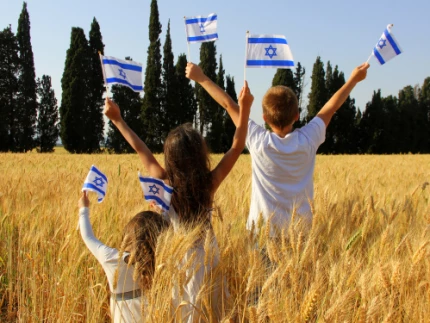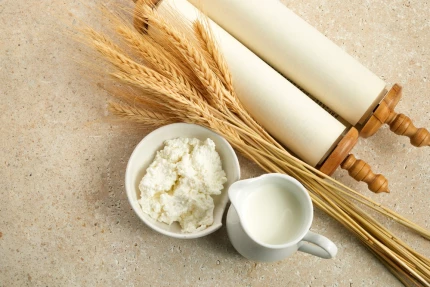Shavuot
Shavuot is a multifaceted Jewish holiday blending agricultural gratitude with sacred history. Celebrated seven weeks after Passover, it marks the wheat harvest (Chag HaBikkurim) and the giving of the Torah at Mount Sinai. Below, we explore its traditions, timing, foods, and modern observances.
an Israeli citizenship specialist
What is Shavuot and How is it Celebrated?
A holiday for farmers and religious pilgrims, Shavuot combines the two notions seamlessly. Its roots strike deep into history and agriculture, as it celebrates some of the most significant events in history. It shows how this important development has left a great mark in history, and the blending of the two in Judaism. Furthermore, it echoes Moses’ revelation of the Torah in Mt. Sinai and how it has shaped Judaism, mystically, philosophically, and spiritually.
Referencing the time period of the festival, the word Shavuot means weeks in Hebrew. It is always done after the Omer period, which spans seven carefully determined weeks, as it is considered to go through immediately after the second night of Passover. In general, this leads to a huge buildup of spiritual tension, preparing for the arrival of Shavuot.
It goes to show the fundamental understanding of God’s message to the Jewish people. Through service of the land and honoring its produce, gratitude is expressed in a very unique way towards the Creator. Compared to other religious celebrations in Judaism, we see Shavuot as being more special. Passover doesn’t fully capture the same mystical essence while Sukkot often has similarities to Shavuot.
When is Shavuot Celebrated?
In Temple times, this was so significant that farmers brought their “first fruits” (bikkurim) as offerings, making Shavuot a spiritual and agricultural New Year of sorts. Its dual identity as both a historical commemoration and a harvest festival is beautifully encoded in its very timing, connecting the giving of Torah at Sinai with the bipartisan natural rhythms of the land of Israel.
The Significance of Shavuot in Judaism
The profound meaning of Shavuot unfolds through two interwoven dimensions – one historical and spiritual, the other agricultural and cyclical. At its spiritual core, Shavuot marks the seminal moment when the Israelite nation stood at the foot of Mount Sinai to receive the Torah through Moses. It wasn’t just the giving of the Ten Commandments: It was God offering the Jewish people an eternal contract — a moment when the people who had once been slaves became a nation bound by divine law and ethics. What we celebrate at Sinai is the spiritual birth of Judaism, and thus Shavuot is, we might say, the birthday of Jewish faith and practice.
Alongside this sacred history runs Shavuot’s rich agricultural significance as the Festival of First Fruits (Chag HaBikkurim). In biblical Israel, this was the jubilant season when, some weeks after the farmers had crammed the last sheaves of their wheat harvest into barns and stooped in the fields to touch with reverence the clay of the earth itself, they set out on pilgrimages to Jerusalem, painstakingly gathering their first and finest produce into ornate baskets. What they would do is take their first fruits, which had been given to them from God, and bring them to the Temple courtyard that was full with other pilgrims’ offerings, they would meet God and thank him in a special ceremony of song and celebration. Although the Temple is no more, contemporary Jews maintain this agricultural link through the use of symbolic customs: synagogues and homes are festooned with fragrant flowers and bountiful greenery, a sensuous reminder of both the harvest and the midrashic tradition that Mount Sinai previously erupted into bloom before the Torah was conferred. The dairy foods customary on Shavuot echo that agricultural theme even further, symbolizing the “land flowing with milk and honey” that was promised to the Israelites. These practices together ensure that Shavuot, even with contemporary celebrations, retains its dual nature as a commemoration of divine revelation and a thanksgiving for earthly bounty.
Traditional Shavuot Foods
Iconic Shavuot Delicacies:
- Cheesecake — The queen of Shavuot tables, this rich treat comes in countless forms in Jewish communities. Ashkenazi Jews tend toward rich New York-style cheesecakes, while Sephardic traditions include lighter ricotta-based versions flavored with rosewater or orange blossom. White signifies purity, while the robot’s circular form echoes the idea that the study of Torah plays out in cycles.
- Blintzes — These thin crepes rolled around sweet cheese or fruit fillings reflect the agricultural roots of the holiday. Ukrainian Jews traditionally serve cheese blintzes with sour cream, while varieties from Hungary may top cherry compote. Its rolled appearance is said to be reminiscent of Torah scrolls.
- Dairy Kugels — Noodle or potato kugels thickened with cheese and sour cream become special Shavuot offerings. Some families include raisins or cinnamon to remember the “manna” that fell in the desert, others make Jerusalemite kugels, which have caramelized sugar for sweetness.
- Sephardic Dairy Dishes – Mediterranean Jewish communities celebrate with bourekas (flaky cheese pastries), savory cheese-filled sambusak, and dairy tagines. Italian Jews might serve ricotta-filled cassola, while Greek communities prepare special cheese pies called tiropites.
This dairy tradition pairs beautifully with the holiday’s agricultural aspect, when many families also bring seasonal first fruits to their tables. Tables may be bedecked with fresh berries and other stone fruits or decorative fruit platters (arranged to resemble the baskets once brought to the Temple). A few communities observe the biblical practice of bringing symbolic “first fruits” to temple services, while others choose edible flowers and herb garnishes to remind of Mount Sinai’s fabled flowering.
Differences Between Shavuot and Pentecost
Although Shavuot and Pentecost have the same historical origin and take place in the same seasonal timeframe, these holidays have developed over the years into two celebrated observances with distinct theological meaning in their respective traditions of faith. Both are in fact intimately related to a symbolic number: Shavuot (Hebrew for “weeks”) celebrates the end of seven weeks from Passover, while Pentacost (from the Greek “pentēkostē” – “fiftieth”) occurs on the fiftieth day from Easter Sunday. This numerical connection alludes to their common roots in ancient Israel’s agricultural calendar, but their modern observances underscore deeply divergent meanings and practices.
Modern Observances of Shavuot
Shavuot as it is now understood in contemporary Jewish life is a colorful medley of old customs and new and dynamic practices that resonate with present-day worshippers while still commemorating the holiday’s deep, traditional roots. Today’s celebrations creatively connect the thousands of years from Sinai to 21st century Judaism, providing diverse avenues toward spiritual connection.
- Tikkun Leil Shavuot — The all-night study session on the eve of Shavuot parallels to many other customs where people dedicate time to reflect after remaining up all night.
- Greenery decorations — Homes and synagogues are decorated with flowers and plants, representing the harvest and the beauty of Mount Sinai.
- Reading the Book of Ruth – This biblical story is traditionally read on Shavuot, as it highlights themes of loyalty, kindness, and the harvest.
FAQ
No, Shavuot is a Jewish holiday, during which work is generally prohibited, much like Shabbat. Observant Jews do not work but pray, study and eat festive meals.
A traditional greeting for Shavuot is “Chag Shavuot Sameach! which means “Happy Shavuot!” in Hebrew. Another way to wish someone a happy Shavuot is to say, “Chag Matan Torah Sameach! which specifically commemorates the giving of the Torah.
The festival of Shavuot is observed with a number of religious and cultural practices, including:
- Attending synagogue services.
- Nightly Torah study sessions.
- Rejoicing in festive meals beside our families and friends, many of which include dairy foods.
- Adorning homes and synagogues with flowers and greenery.
This beloved tradition has a few explanations:
- Song of Songs compares the Torah to nourishing milk
- Before receiving kosher laws at Sinai, the Israelites needed time to make the kosher meat
- The numerical value of the Hebrew word for milk (“chalav”) equals 40, representing Moses’ days on Sinai
- Dairy represents the land flowing with milk promised to the Israelites
The Book of Ruth is read because:
- The story takes place during harvest time, linking to Shavuot’s agricultural aspect
- Ruth’s acceptance of Judaism parallels the Jewish people accepting the Torah
- It teaches lessons about kindness and loyalty, central Torah values
- King David (Ruth’s descendant) was traditionally born and died on Shavuot
| Aspect | Details |
| Date | 6th of Sivan (late May or early June) |
| Duration | 1 day in Israel, 2 days in the Diaspora |
| Significance | Celebrates the giving of the Torah and the first harvest |
| Traditional Foods | Dairy dishes like cheesecake, blintzes, and kugel |
| Key Customs | All-night Torah study, reading the Book of Ruth, decorating with greenery |
an Israeli citizenship specialist

